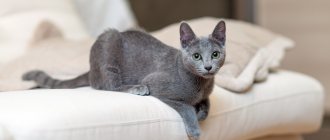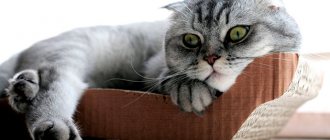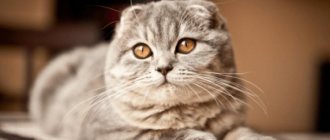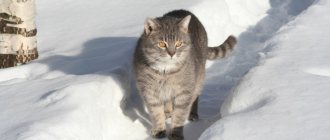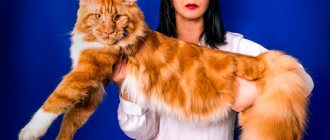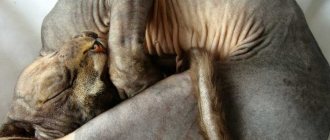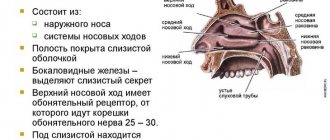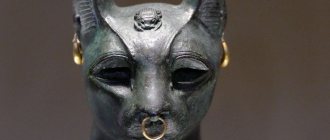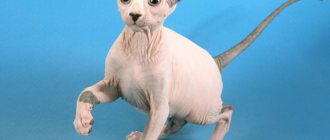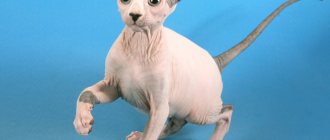The Sphynx cat is a unique breed; despite its somewhat repulsive appearance, these cats have a kind of magic and magnetism. They differ from other breeds in that they lack hair.
It is believed that the Sphynx is one of the oldest cat breeds. During the reign of the ancient Egyptian pharaohs, it was a revered and sacred animal. Hairless Egyptian cats were lost to history, but their species was revived in Canada about 60 years ago.
History of the origin of the breed
Because of their name, sphinxes are associated with Egypt. In fact, animals have nothing to do with this country. Images of hairless cats were found in Mexico. The Aztecs who lived here definitely knew and loved these unusual creatures. There are even photos of Mexican hairless cats. This breed disappeared at the beginning of the 20th century, but managed to leave a lasting impression by participating in exhibitions. The physique of these cats and the Sphynx cats that everyone is familiar with today was slightly different. The Mexican representatives of the bald family had a mustache, their body was more elongated, and their rather large head was wedge-shaped. In addition, when it got colder, representatives of the extinct breed grew fur.
The first representative of the modern Sphinx was born in Canada. This happened in 1966. A cat of an ordinary breed gave birth to a hairless cub. The owner kept the unusual animal, and when it grew up, she decided to try to breed it with its mother cat to produce another generation of hairless animals. The experiment was a success - several hairless kittens saw the light of day.
Around the 70s, a similar story happened elsewhere. Two branches of hairless cats have already appeared. Attempts to breed as many of these unusual animals as possible met with great difficulties - cubs died, cats got sick. Soon, several representatives of the breed were sent to Europe, where breeding attempts continued. There, hairless cats began to be crossed with representatives of the Devon Rex breed - the closest in parameters. Gradually, the Sphynx breed was recognized by all existing organizations - WCF, CFA, FIFe, TICA. Today there are seven varieties of sphinxes in the world.
Sphinxes are very similar to humans: their paws resemble hands, they like to sleep under a blanket, they look straight into the eyes without looking away, which is not typical for animals
Character of hairless cats
All bald people have a friendly character. They are characterized by devotion and love of affection - few hairless cats will allow their owner's embrace to be empty. Pussies make friends with all members of the household, but they experience true love only for those who give them a lot of time and attention.
global $ads_google; //data-ad-slot=”2475549904″ $ads_google = empty($ads_google) ? false : true; ?> if ($ads_google == false) {?> $ads_google = true; ?> } ?>
The price of hairless cats remains high not only because of the special grace of their body, but also because of their developed intelligence.
Animals have a negative attitude towards forced loneliness, so it is better to have them in a large family, where everyone will find time to communicate with the pet.
Types of sphinxes
Three of the varieties of Sphynx that exist today are considered the main branches of the breed. They were the result of a mutation, the causes of which are unknown, i.e. they appeared naturally. Others were developed through selective breeding. The main branches of the Sphynx breed include:
- Canadian;
- Don;
- cohona (rubber, Hawaiian hairless).
The result of breeding programs was the emergence of such breeds as:
- Peterbald;
- minskin;
- bambino;
- Ukrainian Levkoy.
Canadian Sphynx
If the body of a representative of the cat family is devoid of vegetation, this does not mean that he belongs to the Canadian Sphynx breed. The criteria that are the standard for this breed are very strict.
Appearance
Features of the animal’s appearance include rounded, convex shapes, a massive chest and a rather noticeable, spherical tummy. The forelimbs are slightly crooked, which does not prevent the animals from moving gracefully. The length of the hind legs is slightly longer than the front legs. The tail is flexible, medium thick, and has a pointed tip.
The head has the shape of a modified wedge with rounded contours. A feature of the short muzzle is sharply protruding cheekbones and the absence of whiskers (although whiskers may be present). The ears are quite large, rounded at the tips. They are widely spaced and have no brushes. Slightly slanted eyes are shaped like a lemon.
The Sphynx breed has strict standards.
The thick skin of the Canadian Sphynx is covered with numerous folds. Moreover, there are fewer of them with age. If kittens are completely wrinkled, then in adults folds remain only on the head and neck. There are very few “wrinkles” on cats’ stomachs.
A large number of folds is considered an advantage of a hairless cat.
To the touch, as the owners of sphinxes assure, their skin resembles kid suede. The skin is not completely devoid of vegetation, but is covered with short fluff. The color of the animal is distinct. Cats with white and piebald coats are common; tortoiseshell sphinxes are less common. The most beautiful animals are those with mink (coffee with milk) colored fur and heavenly colored eyes.
Tortoiseshell fur color is considered the norm only for Sphynx cats. Cats of this color can be called a natural mistake. The result of the mutation is not only an unusual color - such individuals are not able to leave offspring. Such sphinxes are no longer different from other representatives of the breed.
Character
The temperament of the Canadian Sphynx is quite even. They are unusually attached to their owner, peaceful and good-natured. The animals are absolutely not aggressive; it is almost impossible to anger the Sphinx. They treat their little owners wonderfully and can play with them for hours. The absence of pronounced pain points allows the animal not to feel pain, even if a child accidentally grabs or squeezes it tightly.
Sphinxes are devoid of capriciousness and are absolutely not touchy. But you should not shout at the animal, even if it has done something wrong - if it experiences stress, the pet can receive psychological trauma. Sphinxes are extremely sociable and do not like loneliness. They are not at all afraid of dogs. This is an unusually intelligent and easy to train breed.
The Sphynx is an ideal friend for a child
Don Sphynx
Being one of the few purely Russian cat breeds, the Don Sphynx appeared in 1987. Donchak are muscular, medium-sized individuals. Some call them elongated cats - all parts of their body seem to be able to stretch indefinitely.
Appearance
Compared to representatives of the Canadian breed, Don cats look more massive and have a denser build. Their chest is wide and their muscles are more developed. The tip of their tail is always bare, unlike individuals of the Canadian breed. The eyebrows and cheekbones are clearly defined, the eyes are almond-shaped, and the large ears are slightly tilted forward.
The Don Sphynx differs from the Canadian Sphynx in appearance and is more massive in build.
The Don and Canadian breeds also differ genetically. The Canadian gene is recessive. This means that the inheritance of the gene and all its inherent characteristics by the cubs is possible only if both parents have it.
The Don Sphynx is a carrier of the dominant gene. This means that for the birth of bald offspring, it is enough that one of the parents possesses this gene. This makes breeding hairless cats much easier.
Not all representatives of the Don variety of sphinxes have absolutely no fur. There are four types of Donchak:
- Naked. These animals have no hair at all. The skin is elastic, similar to human skin, but hotter to the touch. These individuals are considered the most valuable.
- Flock. On the skin of these representatives of the breed there is a small fluff that disappears with age.
- Velor. Such animals are characterized by the presence of hairs up to 3 mm long. As they age, they can become completely bald.
The short coat of the velor Sphynx may disappear over time.
- Brush. The short fur of such individuals resembles bristles. They are actively used for breeding, but are considered a “marriage” and are not allowed to participate in competitions.
Character of the Donchak people
Don Sphynxes are sociable and friendly. It is completely uncharacteristic for them to show aggression. They are extremely difficult to tolerate separation from their owner. They are playful and patient with children. Often one of the household members is chosen as the “leader”. His sphinxes love him more and obey him more readily.
Hawaiian Hairless (Cohona)
Unlike other breeds of hairless cats, the Cojona has no hair follicles completely. This means that hair growth is completely impossible for them. This breed can be called one of the rarest . There are very few nurseries for breeding Hawaiian hairless animals, which cannot but affect the cost of these unique creatures, which is determined individually. Only a very wealthy person can afford to have such a pet.
The first official mention of these animals appeared in the 80s of the last century. In 2000, work began on their breeding. Today there are no more than 40 individuals in the world.
The appearance of the cojona is typical for sphinxes - a muscular body, a round tummy, a wide chest. The folds on the body are more pronounced, the eyes are almond-shaped, the ears are large and rounded at the ends.
By nature, Hawaiian hairless ones are similar to dogs and are more dependent on people than representatives of other varieties of sphinxes. Cojones are very calm, do not have conflicts, and are not playful.
Cohona is a completely hairless cat.
Peterbald
The youngest, but already very popular variety of Sphynx is the Peterbald. The characteristic appearance features do not allow this breed to be confused with other representatives of hairless cats.
Peterbalds appeared in 1994 as a result of crossing the Don breed and the Oriental. In 1996, the Peterbald breed was officially recognized by one of the felinological organizations and was given the abbreviation PBD.
The appearance of the Peterbald is distinguished by sophistication and sophistication. It is very similar to the Oriental, differing from this breed only in the absence of hair. Representatives of the breed are distinguished by a strong and muscular body. Their characteristic feature is a curly mustache and low-set ears. Peterbalds have an elongated muzzle, a straight profile, a long nose, and small, slanted eyes.
The character of the Peterbald is typical of the Sphynx. These creatures are calm and balanced. They are distinguished by devotion and do not tolerate loneliness well. Those who constantly disappear at work should not get a Peterbald. A long absence of owners becomes a real tragedy for a pet.
Peterbald is a sophisticated and sophisticated cat
Minskin
Having appeared as a result of long and painstaking work, the Minskin is considered an experimental breed. He is a hybrid of several breeds with mutated genes, which, undoubtedly, can lead to unpredictable consequences. This breed is too young to be able to confidently rule out the possibility of any life-threatening genetic pathologies occurring in the animals. Despite this, in 2008, Minskins were officially recognized by TICA, the largest felinological organization.
To breed this miniature feline, the Sphynx, Devon Rex, Burmese and Munchkin were used. The appearance of the Minskin is original. The main feature, of course, is the wool covering. Quite densely soft fur is present only on the points - darkened areas located on a general light background - the muzzle, ears, paws and tail. The rest of the body is covered with fluff - the animal’s skin feels like velvet to the touch. Minskins are distinguished by their short legs, but this does not prevent them from being agile and agile.
Individuals of this breed are friendly and affectionate. They are very attached to their owners and love to play with children. These animals are smart and easy to train.
Minskin is a small cat, its maximum weight is 4 kg
Bambino
Bambino is an unusual and fairly young breed of cat. Features of appearance prevent these animals from being confused with representatives of other hairless breeds. They owe their appearance to the hairless sphinx and the short-legged munchkin. Today these animals are popular and expensive. The breed has been given experimental status by TICA.
These dwarf cats have no vegetation at all. The body is muscular, the chest is wide, the tummy is rounded. The head is wedge-shaped, not very large. At the tip of the tail there is small vegetation, reminiscent of a lion's tassel. The large, wide-set ears make the bambino look like an elf.
Bambinos are sweet and friendly. Animals constantly need attention, love to play, and get along well with all representatives of the fauna. Bambinos are smart and easy to train. They are able to sit in a kangaroo position for a long time, which looks quite funny.
The bambino's large ears make the cat look like an elf.
Ukrainian Levkoy
Folding ears are a distinctive feature not only of the Scots. The hairless cat, the Ukrainian Levkoy, can also “boast” of an unusual shape of its ears.
The first representative of the breed, the result of crossing a Sphynx and a Scottish Fold, appeared in 2004. In the WCF system, the breed is classified as unrecognized.
The body of the Levkoy is long, muscular, the back is slightly arched. The muzzle is rounded, with pronounced cheekbones and eyebrow lines. The mustache may be wavy, short, or completely absent. Breed standards allow the presence of a small fluff on the skin, but complete absence of hair is considered preferable. There are folds on the neck, between the ears, armpits and in the groin.
Like all representatives of the Sphynx breed, the Ukrainian Levkoy is very loving in nature. These animals are sociable, intelligent and easy to train. They are absolutely not aggressive, not capricious and not vindictive.
Unusual ears add originality to the appearance of the Ukrainian Levkoy
Photo gallery: Sphynx cats
Soft smooth features, velvet skin, devoted gaze of bottomless eyes - all this is the Canadian Sphynx
The body of a representative of the Don breed is more muscular and stronger than that of the Canadian Sphynx
As a result of a genetic mutation, the cojona cannot have hair.
Peterbald is an original cat, recognizable and unlike others
The Minskin is a miniature cat with the short legs of a munchkin and the velvety skin of a sphinx.
Bambinos are entirely domestic cats without a hint of autonomy or independence.
Ukrainian Levkoy is an original cat breed, with two atypical genes: lop-eared and hairless.
Donskoy
The Don Sphynx was bred in Rostov-on-Don, known since 1980, and for a long time this variety was not classified as a Sphynx breed.
Distinctive features of the subspecies:
- toned body, long and thin legs;
- a large number of folds on the body;
- wide ears, rounded at the tip;
- short and thin neck, wedge-shaped head;
- medium, almond-shaped eyes.
Interesting! The peculiarity of Don Sphynx kittens is that they open their eyes within a few hours after birth.
Let's consider several types depending on the presence or absence of hair:
- hairless - the most exotic breed with bare skin;
- velor – at birth there is a velvet fluff on the body, which disappears by the age of 2;
- brush – the animal’s skin is covered with not long, but rough fur.
There are a large number of colors of the Don Sphynx, with the exception of chocolate and lilac.
General features of the breed
The first acquaintance with the Sphinx causes a mixed impression. But as soon as you touch the delicate skin and look into the expressive eyes of the animal, a feeling of attachment to these unusual creatures arises in your heart. Sphinxes are highly intelligent, they are able to understand any words and requests of their owner. They remember their name the first time and easily learn commands.
Bald animals are unusually active, they like to follow their owner, jump, and play. There is something of a dog in their character - they are unusually loyal, and are very bored when alone. This breed is decorative - the animals are completely devoid of the hunting instinct. Sphynxes are non-aggressive and get along well with any animal. They are completely dependent on humans and if they accidentally find themselves alone on the street, they will most likely die.
Sphynx cats are less likely to cause an allergic reaction in humans than other cat breeds
Claims that Sphynx dogs do not cause allergies are greatly exaggerated. The fact is that an undesirable reaction is caused not only by fur, but also by animal protein contained in saliva, urine and dead epidermal cells. But it is a fact that Sphynx cats are hypoallergenic. It is also known that animals with light fur, as well as neutered ones, are less dangerous for allergy sufferers.
Table: pros and cons of the breed
| pros | Minuses |
| Activity | Fear of cold, increased demands for warmth and comfort |
| Sociability and playfulness | Need for special care and frequent bathing |
| Lack of aggression | Susceptibility to skin diseases |
| High intelligence | Complete dependence on a person |
| Fast learner | Tendency to sweating, accompanied by a specific odor that not everyone may like |
Clothing for Sphynx cats
Gentle, trembling sphinxes with their entire appearance make it clear that they love warmth very much. If a hairless cat lives in a warm apartment and does not walk outside, he will not need special clothing.
It is enough to simply arrange a bed for the animal near the battery so that it can spend time with maximum comfort.
IMPORTANT: If the bald Sphynx is taken for a walk outside or on the balcony, you should take care to protect the pet’s delicate body from the winter cold and scorching summer heat.
A winter costume for a sphinx must be windproof and must cover the chest, back and stomach. Having exposed her delicate bald body in the cold, the sphinx can become hypothermic and get sick.
In summer, the Sphynx will need airy, lightweight clothing that will protect the animal from sunburn and heatstroke. You can make clothes for the sphinx yourself or buy them in a specialized store.
Clothes for the sphinx
Defects and diseases of sphinxes
The most vulnerable place of sphinxes is their skin. Due to excess fat and its irregular removal, acne may appear in animals. Predisposition, puberty, and color play an important role in the development of the disease. Cats of all shades of blue and red, completely devoid of vegetation, are more susceptible to the appearance of a rash.
If such a problem occurs, it is better to contact a specialist. Usually Zinerit, salicylic ointment, Delex-Acne or Gepar-sulfur are prescribed.
In addition to skin lesions, hairless animals can suffer from other types of congenital and acquired pathologies:
- Microphthalmos. It is an abnormal development of the baby's eyes that occurs as a result of infection of the mother during pregnancy. The complicated form often ends with a tumor. Surgery can correct the situation.
- Congenital inversion of the eyelids. Manifests itself in an unnatural inward turning of the eyelids. In this case, the eyelashes may touch the eyeball. Treatment is surgical.
- Shortened jaw. This is a congenital anomaly characterized by a lack of alignment between the rows of incisors. It may not be very pronounced and may not affect the condition of the animal. It is recommended to castrate such sphinxes, as they cannot take part in breeding.
- Curvature of the spine in the caudal region. It is accompanied by pathologies of the skeletal system and dysfunction of the gastrointestinal tract, as well as dwarfism. The cause may be heredity or inbreeding.
- Vasculitis. It is an inflammatory process in the blood vessels, manifested in the form of red and blue dotted rashes. The problem may disappear on its own, but complications may also develop. The cause may be the presence of internal diseases, stress, or a reaction to drug therapy.
- Conjunctivitis. It is purulent discharge from the eyes caused by injury, infection, vitamin deficiency.
- Kitten falling asleep syndrome. It often appears in offspring obtained by crossing “rubber” (i.e. completely hairless) individuals. Such cubs are extremely weak, some organs may be absent or not functioning. Nothing can be done to help such kittens.
Features of appearance that do not allow participation in the competition
Sphinxes belonging to the SHOW-quality category (from the English show - spectacle) are allowed to participate in the competition. Their external data fully complies with accepted standards. Defects in appearance that do not allow you to participate in competitions and win prizes include:
- the presence of vegetation in excess of the amount allowed by the standard;
- excessively fragile physique;
- narrow chest, thin stomach;
- curvature of the forelimbs;
- similarity in body type to a Devon Rex, Cornish Rex or Oriental.
If the physique of a Sphynx resembles a Devon Rex, it will not be able to participate in competitions
Individuals with kinks or defects in the tail, structural anomalies, or those behaving excessively aggressively are disqualified. Sphynxes with the above disadvantages (the so-called Pet quality) are not used for breeding.
Where is the best place to buy a Sphynx kitten?
Those who decide to get a Sphynx should definitely contact professional breeders. By purchasing a kitten at a club or at an exhibition, you can avoid problems with the health of the animal and receive guaranteed lifelong information support and support from experts in the breed.
Club Sphynx
If you still doubt whether you should have a Sphynx at home, answer yourself one question: “Do you want to get a reliable, faithful friend who does not remember insults, will be devoted to you, and will never turn away?” If the answer is yes, feel free to cast aside all doubts and take a step towards a small bald miracle.
Rules for choosing a Sphynx kitten
You can buy a purebred Sphynx kitten only in a specialized nursery. Information about trustworthy breeders is available on their official websites. You can also choose a real sphinx at exhibitions.
At cat shows you can purchase a Sphynx kitten from reliable breeders
Criterias of choice
Once you are convinced of the breeder's reputation and have decided to purchase, it is worth observing the kittens in their familiar environment. This way you can choose a pet of a suitable temperament and understand its physical condition. The kitten should be agile and playful, sociable and easy to make contact with.
Healthy little ones should not shake their heads or scratch their ears. The kitten's eyes and ears should be dry and free of discharge. The animal should not have a bloated abdomen, it should not cough, sneeze, or be lethargic or lethargic. If you notice signs of illness in at least one of the individuals present in the nursery, you should refuse to purchase.
A responsible breeder is obliged to provide a certificate of registration of the cattery, information about the pedigree of the parents, diplomas about their receipt of various awards and, of course, present the mother cat herself.
When purchasing a pet, a sales contract must be drawn up. Along with the animal, the breeder must submit a birth certificate, pedigree and veterinary passport.
At what age is it better to buy a Sphynx?
Pedigree animals are usually considered ready for sale when they reach 3 months of age. Such kittens are already ready to be separated from their mother and have mastered the first necessary skills. By this time, the course of vaccinations ends and it becomes possible to assess how well the pet meets the breed standards.
Nicknames suitable for Sphynx cats
Even the Sphynx kittens look majestic and proud, their entire appearance reminiscent of Egyptian figurines. Calling the Sphynx a simple cat name, such as Timka or Fluff, doesn’t even occur to us.
In order not to invent anything new, you can simply look at the list of names of Egyptian gods. A name suitable for the little miracle will be found there quickly.
For example, a Sphynx cat can be named after one of the goddesses: Amaunet, Anuket, Isis, Seshat, Sioux . Suitable names for a sphinx boy are: Aker, Amat, Amset, Anhur, Geb, Mafdet, Onuris, Osiris, Hapi, Hesat, Khnum, Shai, Yah.
The names of ancient Egyptian gods suit the majestic sphinxes
Features of caring for the Sphinx
The main rule of caring for a Sphynx is the need for regular water procedures - at least 2 times a month. First, remove dirt from the animal using soapy water and a soft washcloth, and then rinse it. After bathing, the sphinx is dried with a towel using soft “blotting” movements and wrapped warmly. Too frequent water treatments are not good for the animal - water washes away the natural lubricant that prevents the development of inflammatory processes. In addition to water hygiene procedures, the skin of hairless animals is treated daily with soft wipes.
Sphynx cats also require regular manicures, as sweat mixed with dirt quickly clogs the space under their overgrown claws. The visible parts of the ears also need to be cleaned of dirt. This should be done using cotton swabs soaked in warm water.
Nutrition
Representatives of the Sphynx breed have an excellent appetite. They are not too picky about food and can happily eat even plant foods. The owner must control the frequency and balance of food intake. Sphynx cats should be fed 3 to 4 times a day. The diet must include raw fish, meat (beef and lamb), boiled liver, fermented milk foods, and fresh plant products.
Sphynx cats love to try new foods
Walk
Sphinxes should not be allowed to roam during the cold season. In the mid-season, animals should be dressed in overalls or use a carrier. With the arrival of warm days, you can take walks every day. Hairless animals love to bask in the sun; the owner’s task is to prevent the pet from getting burns.
Toilet
There are no special recommendations for arranging a toilet for the Sphinx. It is better to choose a plastic tray; it should be washed frequently, but without using disinfectants, the smell of which can scare away the animal. The filler can be anything - the main thing is that the pet likes it. Some people make do with just a tray.
Video: features of the breed and its care
The history of breeding velor sphinxes
All types of hairlessness of the Don and St. Petersburg Sphynxes are based on the dominant Hbl gene, which determines the main characteristics of these breeds and their breeding. Velor wool covering is one of the most popular - it looks impressive and does not create big problems in maintenance.
Velor Sphynx kitten is an incredibly charming creature
Don Sphynx velor
The Varvara cat, with whom the Don Sphynx breed is believed to have begun, was velor-point according to the modern classification of coat and blue-cream “tortoise” according to the color type. This strange kitten was taken from the boys on the street by Rostov resident Elena Kovaleva in 1986 - and at that very moment she entered the history of felinology. She was very sorry for the “shabby” baby and tried to fatten her and cure her. The cat grew up and felt great, but there was even less hair on her.
Varvara's children also had a velor covering; a baby named Chita attracted the attention of Elena’s friend Irina Nemykina, who later became the founder of the Don Sphynx breed, making titanic efforts to develop and recognize it. The new breed was recognized by the WCF in 1998, after which it received recognition from other felinological organizations around the world. Until 2000, matings with Siberian and European shorthair cats were allowed.
This is what the modern Don Sphynx looks like
The Donchaks have several breed standards, the differences of which are insignificant. Velor Don Sphynxes are characterized by hot, wrinkled skin with a delicate coat of hair that creates a small collar around the head. Young animals may have excessive hair. In winter, the growth also increases. The vibrissae are convoluted and break off easily.
The WCF and SFF standards allow all colors, while the IFF standard prohibits lilac and chocolate. The colors of the eyes, nose and fingertips should be in harmony with the main color.
Velor Peterbald
In the group of sphinxes, this breed is the youngest; it was the result of interbreeding of Donchak with Orientals, which gave its representatives a unique appearance. The first experimental mating took place in 1994, and the offspring lived up to the wildest hopes - excellent material was obtained for further selection. Today, interbreed matings between St. Petersburg and Don Sphynxes are prohibited. The breed received international recognition from the WCF in 2003.
The Peterbald's elegant appearance contributes greatly to its popularity.
The WCF standard allows any colors for St. Petersburg Sphynxes, but the preferred eye color is green, and in color-point varieties - blue. The skin of a velor Peterbald is flexible, very delicate, the quality of wool velor is the same as that of the Don Chaks; The presence of vibrissae is highly desirable. The color of the finger pads and nose should be in harmony with the main color.
Knitting features
Before breeding Sphynxes, it is necessary to take into account that completely hairless cats cannot be mated with the same cats. As a result of such a union, offspring with various pathologies may appear. Ideally, one of the parents will be bald, and the other will have brush or velor.
The cat should go on a “date”. Ideal for mating are individuals who have already gone through two heats - this is approximately one and a half years old. A sign for a cat to visit is the animal's excessive affection - the cat rubs against everything, and when you stroke its back, it purrs, arches and trembles. A cat will help you figure out exactly whether he is ready for mating - if the kitty arrived on time, he will immediately show his readiness for affection, filling the room with a loud cry. If the time has not yet come, the cat may leave altogether. A guaranteed result can be achieved only after several matings.
Character and behavior
Owners of “bald cats” are convinced that their pets have the highest level of intelligence among domestic cat breeds - it is quite possible that this is so. All Sphynx cats are very affectionate and affectionate cats. They are dog-oriented and interested in their owner, they train well and explore the world around them with great curiosity.
The Sphinx cannot imagine her life without her beloved owner
Loneliness is not for them, keep this in mind if you are planning to get a Sphynx. Donchak dogs are more self-confident and, at least for a short time, will be able to find something to do to pass the time while waiting for the owner. Canadians are very sensitive, withdrawn and fixated on their rich inner world - being left without an owner, they suffer greatly. Peterbalds are emotional, active and will constantly “tell” you about all their activities and fun.
These cats are bright, unique personalities, and this certainly has nothing to do with the type of coat they have. Much more important is whether you can find mutual understanding with them - then your life will become more interesting and sparkle with new colors.
Photo gallery: sphinxes live next to us - interesting facts
They are friendly with pets and seem to consider themselves a bit of a dog.
Sphynxes feel almost no pain and often get burned while warming themselves on a stove or radiator.
They love to dress up and take pictures
The Sphinx is ready to follow its owner everywhere
The hunting instinct of sphinxes is highly developed. They are cunning and gluttons - it is better to hide food from them.
they know how to not only warm their owner, but also treat him. Sphinxes like shiny toys, why is unknown
An uncomfortable or ugly outfit can greatly spoil the sphinx’s mood.
The Sphinx needs to be dressed for walks so that the grass does not cut the delicate skin
Sphynxes love to sleep in the embroidered position - it’s warmer.
Sphynx cats recognize themselves in the mirror; other cats rarely do this.
They say that they understand humor - but they definitely know how to smile!
Castration and sterilization
Differing in the mechanism of implementation, castration and sterilization are operations to artificially disrupt the reproductive function of an animal. Owners who do not want to have offspring from their pets resort to one of these methods. The advantages of these manipulations:
- the life expectancy of pets increases;
- the animal’s hormonal levels stabilize, it becomes calmer, stops making loud sounds and marking;
- the risk of such pathologies as ovarian cysts, inflammation of the uterus and some others is reduced.
Neutered animals produce less allergenic protein, which reduces the risk of adverse reactions in humans.
An animal needs sexual intercourse only to reproduce. Violation of reproductive function through surgical intervention does not negatively affect the health of the pet. Castration must be carried out before the onset of puberty.
Description and general breed standard
The Sphynx cat is naturally endowed with a slender and, not surprisingly, strong and muscular body. The main difference is, of course, the skin, which has no hair or barely noticeable cover.
It is a mistake to assume that all representatives of this breed are bald - the Sphynx with hair is not new for a long time.
What also makes the Sphynx stand out is its large, slightly pointed, erect ears and almond-shaped eyes. The head is diamond-shaped. The nose is straight and flat. In general, such an elegant muzzle is a bit reminiscent of unearthly creatures. The slender, flexible body flows smoothly into long limbs and a straight, thin tail.
The color of the sphinx can be completely different: plain, spotted, two-color, bicolor (when in addition to one main shade there is another color). Also, a cat can simply tan, thereby changing color.
As for the pregnancy of Sphynx cats, it proceeds quite favorably and calmly. During this period, you should not introduce the expectant mother to new foods, but you need to feed her more often. Despite the uniqueness of the breed, a pregnant Sphynx cat needs the same care as all felines during this period. Between two and five kittens are born in a litter.
How to choose a kitten
When choosing a kitten, you need to pay attention to its health. Such an animal should show playfulness, activity, and curiosity towards a new person. He should not have any discharge from his eyes or ears. The release of eye fluid is allowed, but only transparent and odorless. Also, the new pet must have all the documents, which include its pedigree, veterinary passport, and current vaccinations, which the breeder must provide it with.
How much do Sphynx kittens cost?
Purebred kittens are purchased only in nurseries. Such organizations have all the documents and deal only with verified animals, buy sick or not purebred. A kitten without documents and history can be bought from advertisements on the Internet for just a few thousand. The price for animals from the breeder starts from 10,000 to 50,000 rubles.
General information
Now it is impossible to say whether the ancient sphinxes were the result of selection, whether they had some wild roots or appeared as a result of a random gene mutation.
Mexican hairless cats most likely had the same mutational development path as hairless Mexican dogs. But, alas, the sphinxes from the South American continent also did not survive to this day and their path of appearance and disappearance is also impossible to trace.
Modern hairless Sphynx cats are the result of a random mutation, which to this day they are trying to strengthen through targeted selection. The first bald kitten of our time was born in Canada in Ontario and received the nickname Prune. Unfortunately, all attempts to turn one hairless cat into the breed's first breeding stock failed, but it sparked hope in the minds of many breeders for an extravagant new breed.
So the next successful experiment in selecting hairless litters was crowned with success in the USA and Canada at the same time, where 4 hairless kittens were born from smooth-haired cats. Breeders from neighboring countries made a joint decision and, by crossing litters with Devon Rex, received the first representatives of the new breed. The name was given after the place of birth - the Canadian Sphynx.
Now the process of selection and breeding of new hairless cat breeds does not stop. In addition to the Canadian Sphynx, there are the Don Sphynx and the Peterbald. These are three breeds that are quite stable and are presented at exhibitions as independent species of Sphynx cats.
First mentions
We find the earliest information about cats lacking hair in antiquity, the annals of Egypt and the legends of the ancient Aztecs. There is reason to believe that they are descendants of a extinct breed - the Mexican Hairless, whose representatives finally disappeared in the 19th century. Its characteristic features were:
- long body;
- wedge-shaped head;
- long mustache;
- fur on the back and tail, disappearing in summer;
- amber colored eyes.
There are also known references to the Egyptian sphinx, figurines of which are found in the tombs of the pharaohs. According to legend, they were intermediaries between the world of people and gods, guarding the entrance to the tomb of the pharaohs.
Advantages and disadvantages
When choosing a breed that you plan to get, the choice often falls on Sphynxes. But before that, you need to know everything about sphinxes, their differences, features, habits, and most importantly, their advantages and disadvantages. The main advantages of sphinxes are:
- activity;
- curiosity, but sometimes this can be considered a disadvantage;
- tenderness and affection;
- communication skills with people and animals.
The disadvantages include the need to frequently bathe the animal, otherwise it will dirty the furniture, leaving gray-yellow stains on it. They are also afraid of the cold; the owner must monitor the temperature in the apartment very closely. Sometimes a cat can get bored with a person due to over-attachment.
Interesting Facts
For those interested in Sphynxes, here are a few facts about these cute cats:
- They have an excellent appetite, as their body quickly gives off heat.
- Hairless cats come in different colors and even patterns on their bodies in the form of spots or stripes.
- Although the Sphynx seems too hot, its body temperature is almost the same as that of representatives of other breeds, only 0.5 degrees higher.
- A hairless cat can easily learn to open door handles and perform other manipulations.
- The Canadian Sphynx is not suitable for allergy sufferers.
